Poole Ch.P., Jr. Handbook of Superconductivity
Подождите немного. Документ загружается.

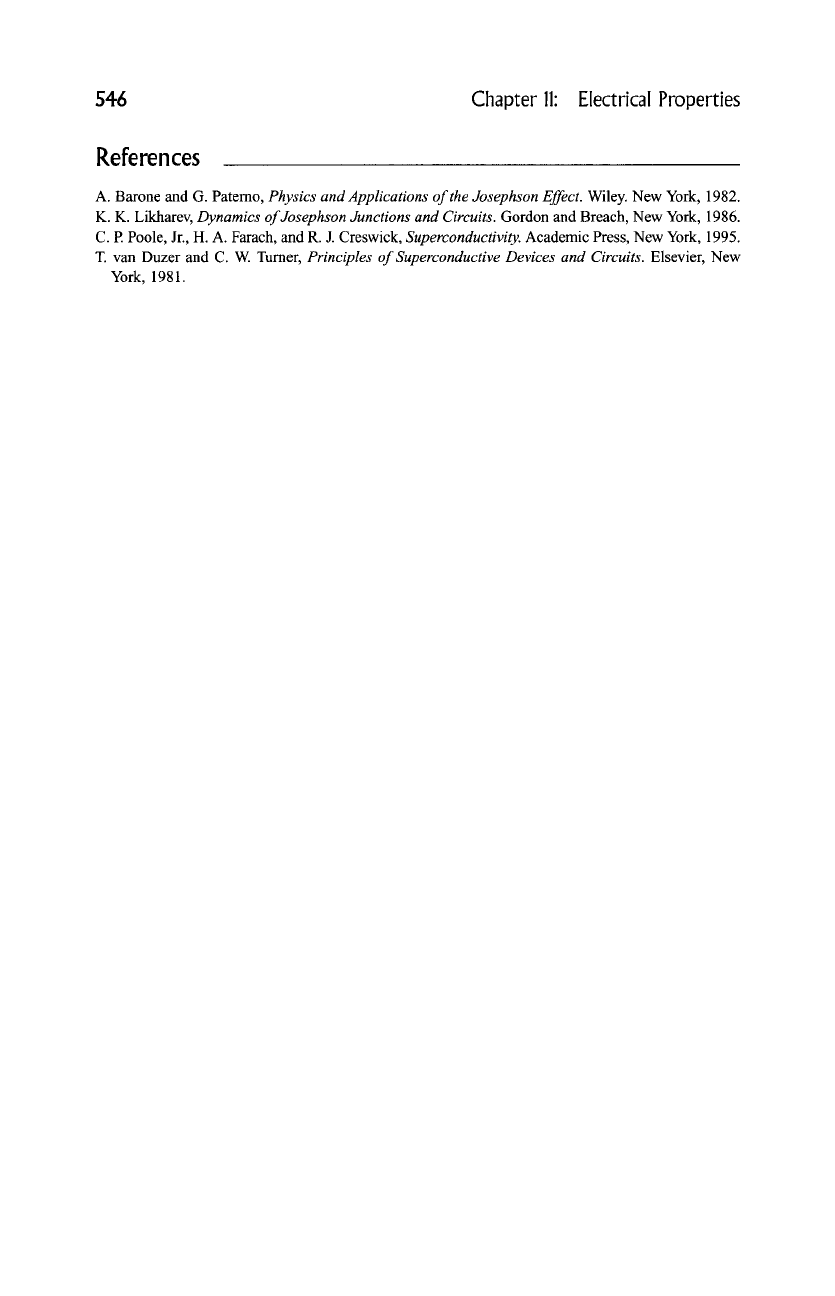
546 Chapter 11: Electrical Properties
References
A. Barone and G. Paterno,
Physics and Applications of the Josephson Effect.
Wiley. New York, 1982.
K. K. Likharev,
Dynamics of Josephson Junctions and Circuits.
Gordon and Breach, New York, 1986.
C. P. Poole, Jr., H. A. Farach, and R. J. Creswick,
Superconductivity.
Academic Press, New York, 1995.
T. van Duzer and C. W. Turner,
Principles of Superconductive Devices and Circuits.
Elsevier, New
York, 1981.
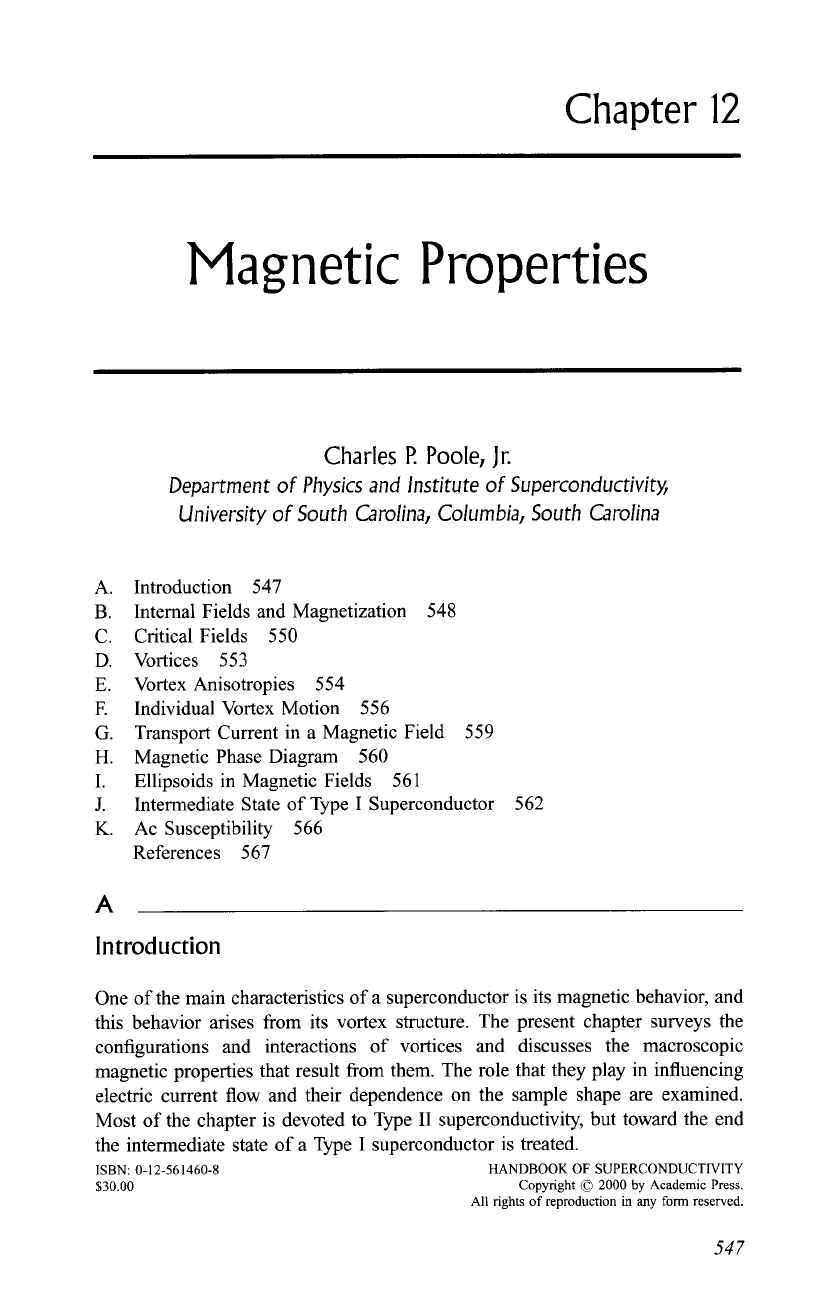
Chapter 12
Magnetic Properties
Charles P. Poole, Jr.
Department of Physics and Institute of Superconductivity,
University of South Carolina, Columbia, South Carolina
A. Introduction 547
B. Internal Fields and Magnetization 548
C. Critical Fields 550
D. Vortices 553
E. Vortex Anisotropies 554
E Individual Vortex Motion 556
G. Transport Current in a Magnetic Field 559
H. Magnetic Phase Diagram 560
I. Ellipsoids in Magnetic Fields 561
J. Intermediate State of Type I Superconductor
K. Ac Susceptibility 566
References 567
A
562
Introduction
One of the main characteristics of a superconductor is its magnetic behavior, and
this behavior arises from its vortex structure. The present chapter surveys the
configurations and interactions of vortices and discusses the macroscopic
magnetic properties that result from them. The role that they play in influencing
electric current flow and their dependence on the sample shape are examined.
Most of the chapter is devoted to Type II superconductivity, but toward the end
the intermediate state of a Type I superconductor is treated.
ISBN: 0-12-561460-8 HANDBOOK OF SUPERCONDUCTIVITY
$30.00 Copyright 9 2000 by Academic Press.
All fights of reproduction in any form reserved.
547
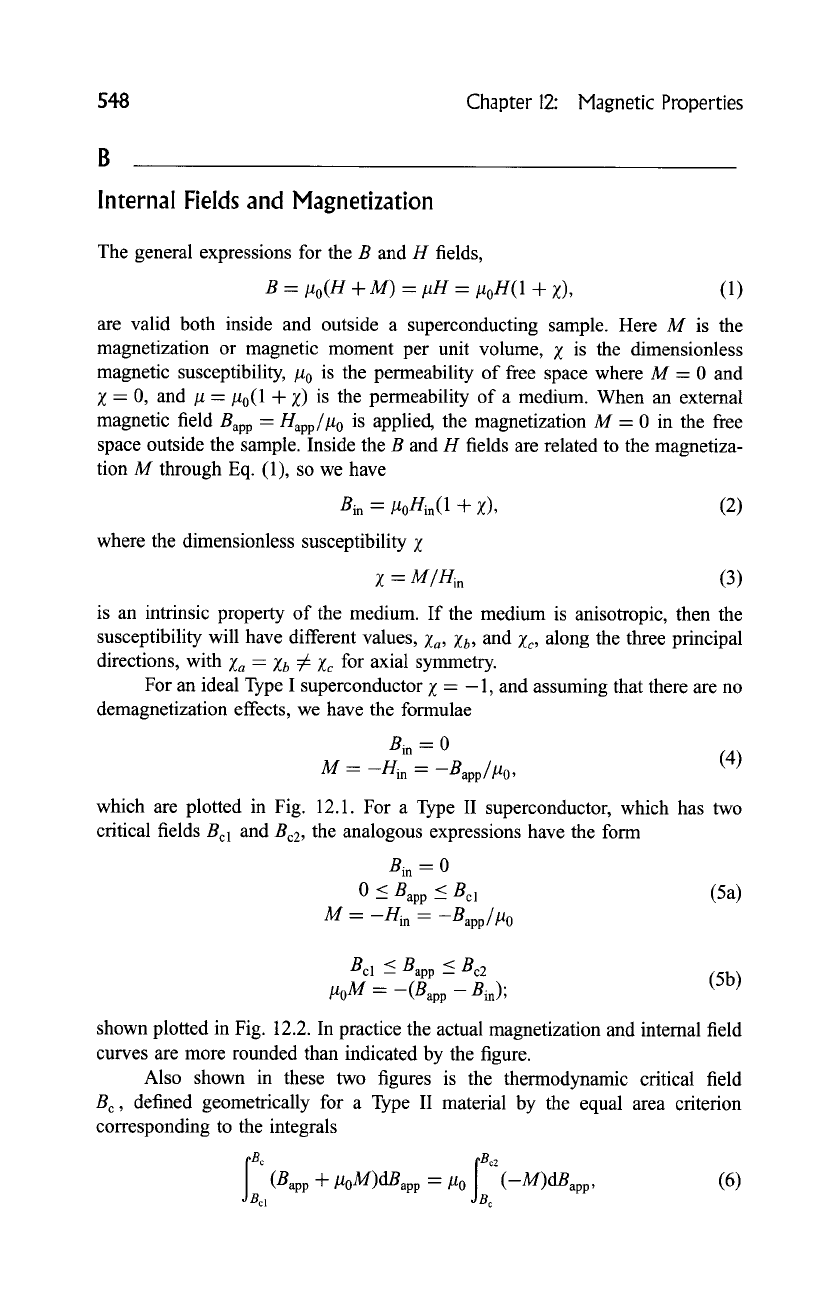
548
Chapter 12: Magnetic Properties
Internal Fields and Magnetization
The general expressions for the B and H fields,
B - #o(H + M) - ttH - #oH(1 + Z),
(1)
are valid both inside and outside a superconducting sample. Here M is the
magnetization or magnetic moment per unit volume, Z is the dimensionless
magnetic susceptibility, #0 is the permeability of free space where M- 0 and
g = 0, and #- #0(1 + Z) is the permeability of a medium. When an external
magnetic field Bap p = Happ/#0 is applied, the magnetization M = 0 in the free
space outside the sample. Inside the B and H fields are related to the magnetiza-
tion M through Eq. (1), so we have
Bin - #0Hin( 1 q- Z), (2)
where the dimensionless susceptibility Z
Z -- M/Hin
(3)
is an intrinsic property of the medium. If the medium is anisotropic, then the
susceptibility will have different values, Za, gb, and gc, along the three principal
directions, with Za
= ~b ~
Xc for axial symmetry.
For an ideal Type I superconductor Z -- -1, and assuming that there are no
demagnetization effects, we have the formulae
Bin
- 0
M -- -Hin
-- --Bapp//A0,
(4)
which are plotted in Fig. 12.1. For a Type II superconductor, which has two
critical fields Bcl and Bc2 , the analogous expressions have the form
Bin - 0
0 < Bap p < Bcl
M -- -/-/in -- -Bapp/#0
(5a)
Bcl < Bap p < Bc2
#0 M
_ _(Bapp _ Bin);
(5b)
shown plotted in Fig. 12.2. In practice the actual magnetization and intemal field
curves are more rounded than indicated by the figure.
Also shown in these two figures is the thermodynamic critical field
B c , defined geometrically for a Type II material by the equal area criterion
corresponding to the integrals
I•c
[Bc2
(Bapp "~- #0M)dBapp - #0 (-M)dBapp,
(6)
cl dBc
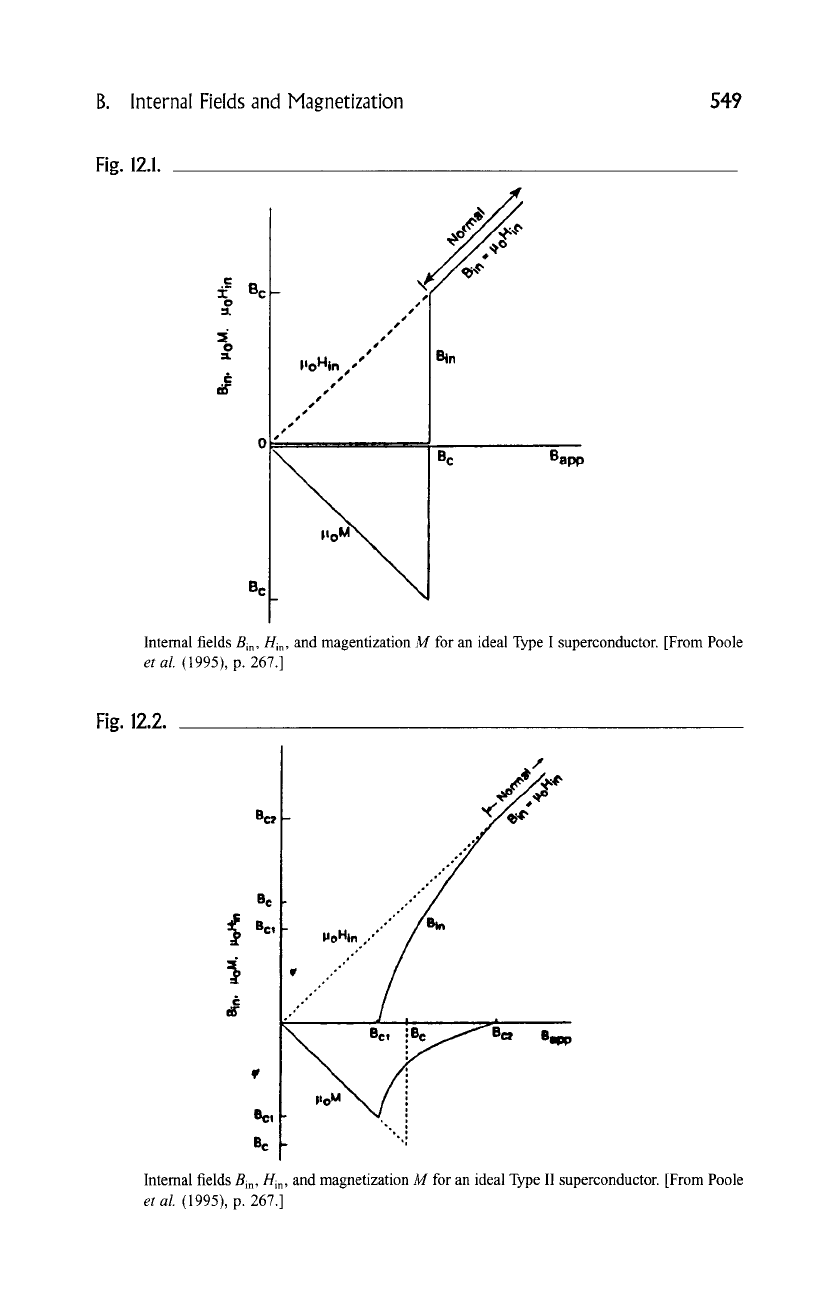
B. Internal Fields and Magnetization S47
Fig.
12.1.
C
•
B c
0
=1.
O
Iff
s
t
lloHln,, oS
I
I
t
O' ......
Bc
Bc Bapp
Intemal fields Bin , Bin , and magentization M for an ideal Type I superconductor. [From Poole
et al.
(1995), p. 267.]
Fig. 12.2.
f
x" *
Bc~ -
..o...'"'"
Br .
..""
~
...~
Be.
Internal fields Bin ,/-/in, and magnetization M for an ideal Type II superconductor. [From Poole
et al.
(1995), p. 267.]
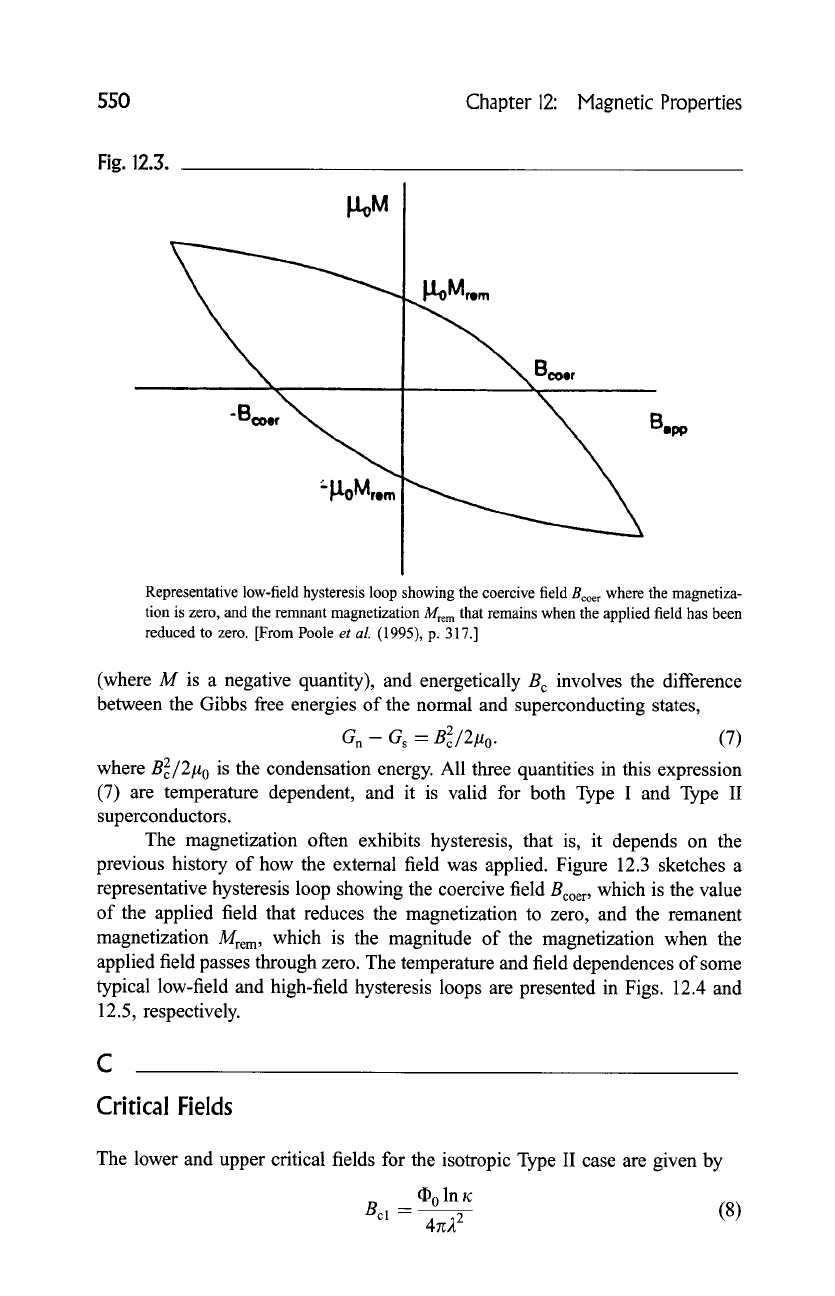
550
Chapter
12:
Magnetic Properties
Fig. 12.3.
"Boo,,
Bco,r
~'J.l.0Mmm
Representative low-field hysteresis loop showing the coercive field Bcoer where the magnetiza-
tion is zero, and the remnant magnetization
Mre m
that remains when the applied field has been
reduced to zero. [From Poole
et al.
(1995), p. 317.]
(where M is a negative quantity), and energetically B c involves the difference
between the Gibbs free energies of the normal and superconducting states,
G n
--
G s --
B2/2~o .
(7)
where
B2/2#o
is the condensation energy. All three quantities in this expression
(7) are temperature dependent, and it is valid for both Type I and Type II
superconductors.
The magnetization often exhibits hysteresis, that is, it depends on the
previous history of how the external field was applied. Figure 12.3 sketches a
representative hysteresis loop showing the coercive field Bcoer, which is the value
of the applied field that reduces the magnetization to zero, and the remanent
magnetization Mrem, which is the magnitude of the magnetization when the
applied field passes through zero. The temperature and field dependences of some
typical low-field and high-field hysteresis loops are presented in Figs. 12.4 and
12.5, respectively.
C
Critical Fields
The lower and upper critical fields for the isotropic Type II case are given by
~o InK
Bcl -- (8)
47~ 2
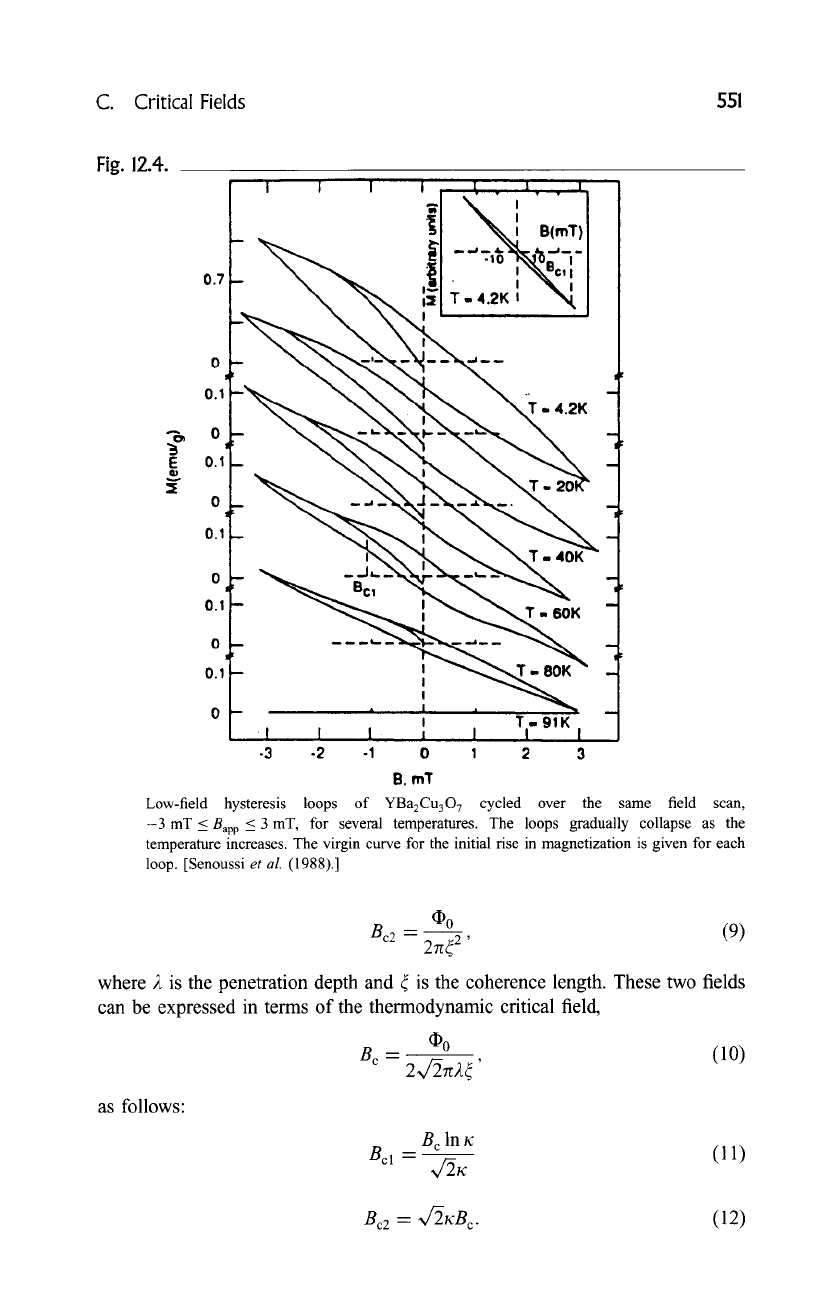
C. Critical Fields 551
Fig. 12.4.
0.7
~1 B(mT)
.,o
N.o,',
9 I I
0.1
9 "~ 0
E 0.1
G)
v
0
T - 4.2K
0.1
0_
0.0 -I,,- ~~T.60K
o,j
,
0
........... -
I "I" ,, gIK
-3 -2 -1 0 1 2 3
B. mT
Low-field hysteresis loops of YBa2Cu307 cycled over the same field scan,
-3 mT < Bap p < 3 mT, for several temperatures. The loops gradually collapse as the
temperature increases. The virgin curve for the initial rise in magnetization is given for each
loop. [Senoussi
et al.
(1988).]
(I) o
Bc2 = 2~z~2,
(9)
where 2 is the penetration depth and ~ is the coherence length. These two fields
can be expressed in terms of the thermodynamic critical field,
(I)~ (10)
Be 2~/2rt2~ '
as follows:
B c
InK
Bcl -- %/~K (11)
Bc2 - ~/2trB c. (12)

552
Chapter 12: Magnetic Properties
Fig. 12.5.
I'
I
I
Bcs I
I
I
I
T=~
0
4-
0
4 ~
0
4'
0
iv .i
!
X,.. ~, ~~,... T - 40K
9 ''~L
9 ~
""
I T - (X)K
_ _. , ~, 9 . 9
,,
i T 80K
9 , _ ,
;3' .~ .', o , ~ B(~)
High-field hysteresis loops ofYBa2Cu307 cycled over the same field scan, -3T _< Bap p _ 3T,
for several temperatures. The loops gradually collapse as the temperature increases. The
deviation of the virgin curve from linearity occurs near the lower critical field Bcl , which
increases as the temperature is lowered. [Senoussi
et al.
(1988).]
tr 2/~ is called the Ginzburg-Landau parameter. Figure 12.2 shows the
position of the lower and upper as well as the thermodynamic critical field on
the magnetization curve, and Tables 9.1, 9.2, 9.4, and 9.5 respectively, lists the
isotropic length parameters and critical fields of some Type II superconductors.
The bulk of the material goes normal when Bap p reaches Bc2 , but the super-
conducting state can persist in a thin surface sheath for Bap p up to the higher
applied field value Be3 = 1.7 Bc2.
The thermodynamic critical field B~ is related to the depairing current
density
Jdepair
through the expression
Jdepair --
~Bc/#02, (13)
where the dimensionless coefficient ~ is of the order of unity.
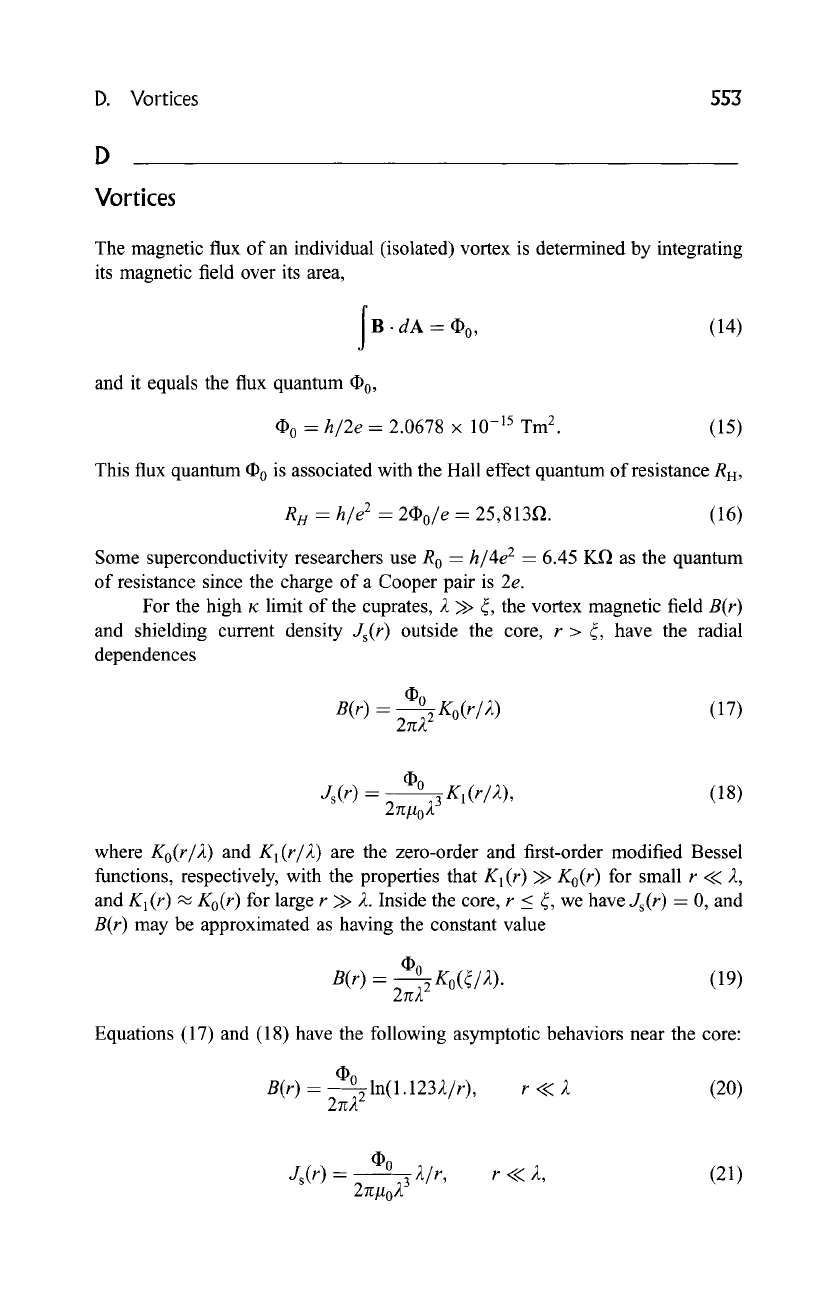
D. Vortices 553
D
Vortices
The magnetic flux of an individual (isolated) vortex is determined by integrating
its magnetic field over its area,
I
B.dA-~ o, (14)
and it equals the flux quantum ~0,
~o = h/2e
= 2.0678 • 10 -15 Tm 2.
(15)
This flux quantum ~0 is associated with the Hall effect quantum of resistance R H,
RI_ I = h/e 2
= 2~0/e = 25,813~.
(16)
Some superconductivity researchers use R 0 =
h/4e 2
= 6.45 Kf~ as the quantum
of resistance since the charge of a Cooper pair is 2e.
For the high ~c limit of the cuprates, 2 >> {, the vortex magnetic field
B(r)
and shielding current density Js(r) outside the core, r > ~, have the radial
dependences
B(r) - Oo~ Ko(r/2 )
(17)
27z~, 2
(I) 0
Js(r) --
KI(F/,~),
(18)
2~Z/~o/~ 3
where
Ko(r/2 )
and
Kl(r/~, )
are the zero-order and first-order modified Bessel
functions, respectively, with the properties that Kl(r ) >>
Ko(r )
for small r << 2,
and K 1 (r) ~
Ko(r )
for large r >> 2. Inside the core, r _< ~, we have Js(r) = 0, and
B(r)
may be approximated as having the constant value
(I) 0
B(r) --
7----7~ K0(~/2). (19)
2~zZ"
Equations (17) and (18) have the following asymptotic behaviors near the core:
(I) 0
B(r)-
z--zv.~ ln(1.1232/r), r << 2 (20)
2~zZ"
~o 2/r, r
<< 2, (21)
Js(r) - 2rc#0~3
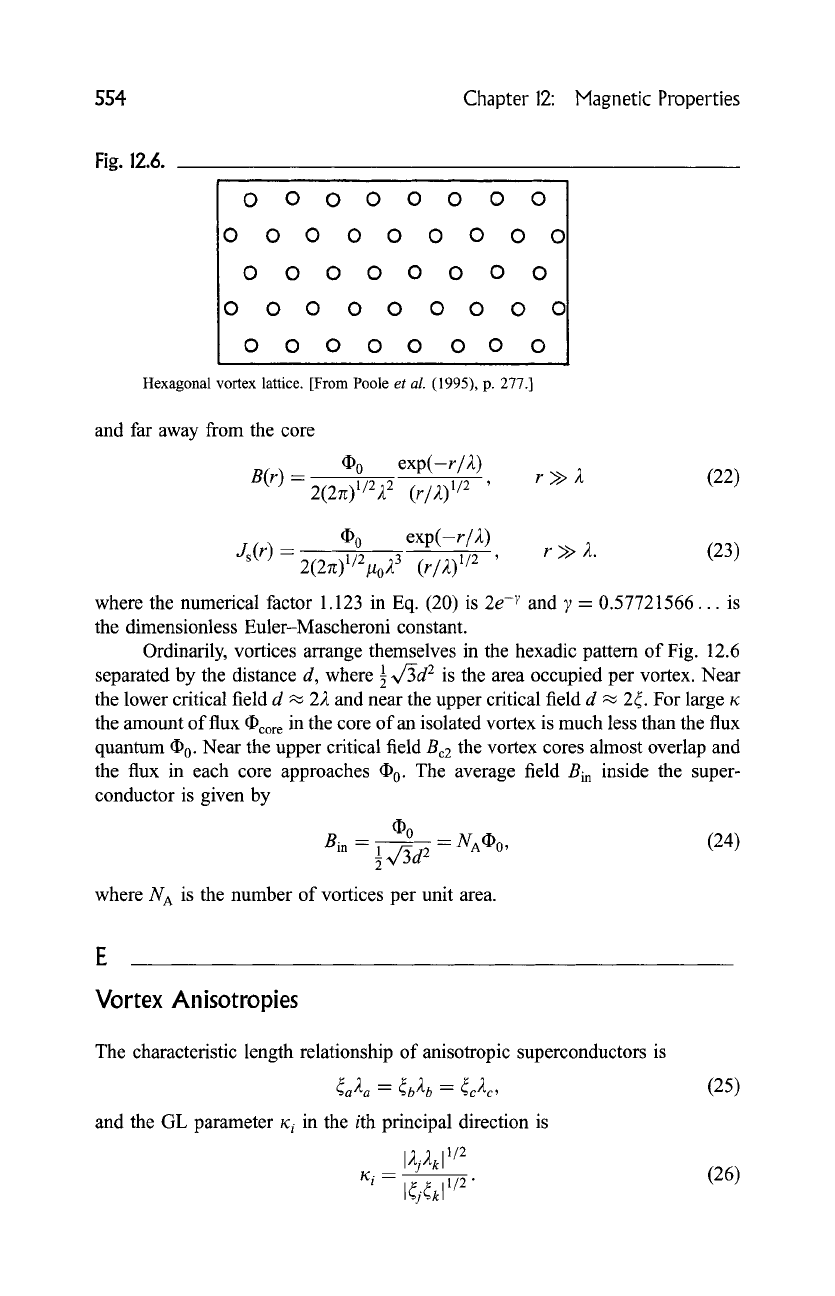
554 Chapter 12: Magnetic Properties
Fig. 12.6.
0 0 0 0 0 0 0 0
0 0 0 0 0 0 0 0 0
0 0 0 0 0 0 0 0
0 0 0 0 0 0 0 0 0
0 0 0 0 0 0 0 0
Hexagonal vortex lattice. [From Poole
et al.
(1995), p. 277.]
and far away from the core
9 0 exp(-r/2)
B(r)
--
2(2~)1/2)~ 2
(r/~)l/2 ,
r >> 2 (22)
~o exp(-r/2)
Js(r) 2(2rc)1/2#023
(r/2) 1/2'
r >> 2. (23)
where the numerical factor 1.123 in Eq. (20) is 2e-~ and 7 = 0.57721566... is
the dimensionless Euler-Mascheroni constant.
Ordinarily, vortices arrange themselves in the hexadic pattern of Fig. 12.6
separated by the distance d, where 1 ~/~d 2 is the area occupied per vortex. Near
the lower critical field d ~ 22 and near the upper critical field d ~ 2~. For large tr
the amount of flux Ocore in the core of an isolated vortex is much less than the flux
quantum 9 0. Near the upper critical field Bc2 the vortex cores almost overlap and
the flux in each core approaches ~0. The average field Bin inside the super-
conductor is given by
(I) 0
Bin = 1 C'~d 2 = NA~O' (24)
2
where N A is the number of vortices per unit area.
Vortex Anisotropies
The characteristic length relationship of anisotropic superconductors is
~a2a -- ~b2b -- ~c/~c,
and the GL parameter/s in the/th principal direction is
12j2kl 1/2
Ki = 1/2"
Ir162
(25)
(26)
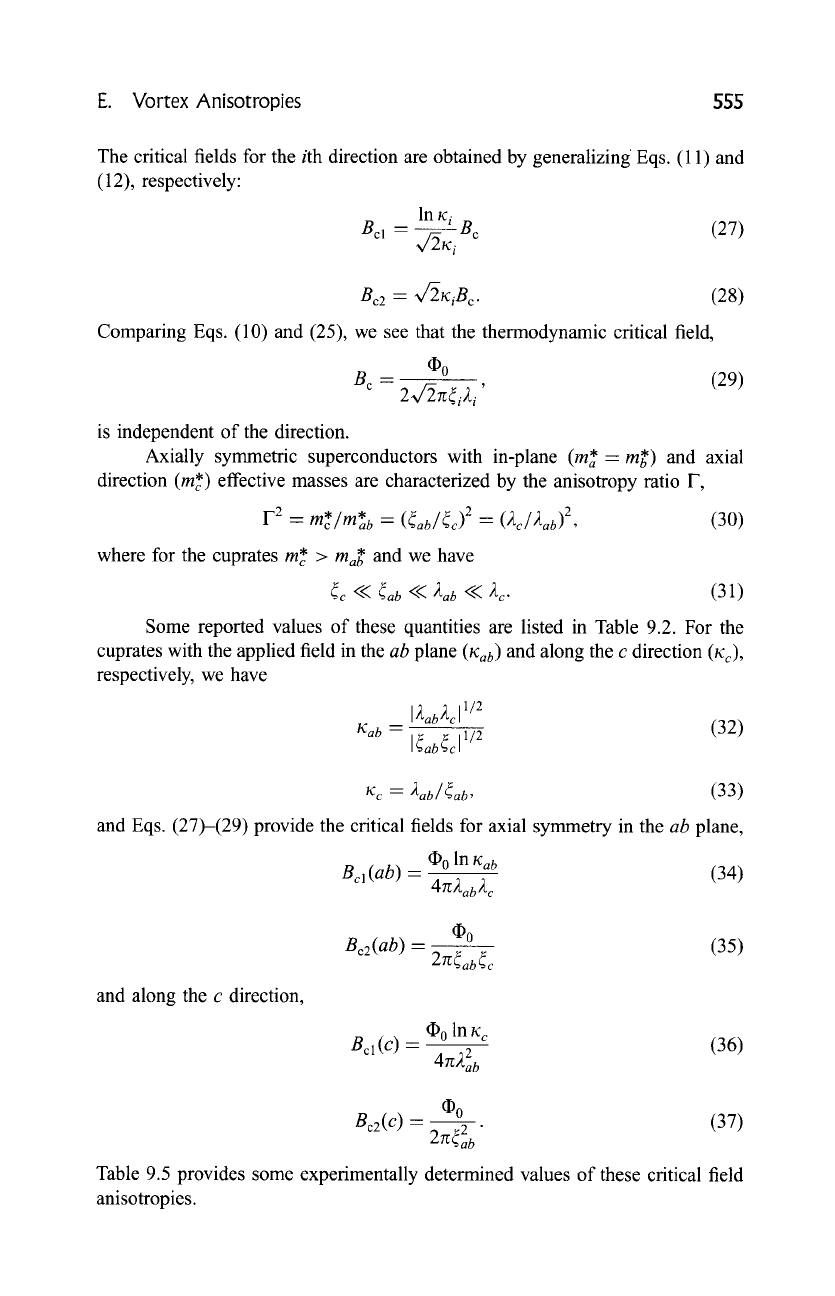
E. Vortex Anisotropies 555
The critical fields for the ith direction are obtained by generalizing Eqs. (11) and
(12), respectively:
In gi
Bcl --
~/~giBc
(27)
Bc2 --
~/-2giBc .
(28)
Comparing Eqs. (10) and (25), we see that the thermodynamic critical field,
O0
B e 2~/~rc~i2i
(29)
is independent of the direction.
Axially symmetric superconductors with in-plane (m*- m~') and axial
direction (m*) effective masses are characterized by the anisotropy ratio F,
F 2 9 9
-- me/mat, -- (~ab/~c) 2 -- (2c/2ab) 2,
(30)
where for the cuprates m* >
ma" ~
and we have
~c << ~ab << 2ab << 2c" (31)
Some reported values of these quantities are listed in Table 9.2. For the
cuprates with the applied field in the
ab
plane (gab) and along the c direction (gc),
respectively, we have
[2ab2cl 1/2
gab = iCabr
(32)
gc -- ~ab/~ab,
(33)
and Eqs. (27)-(29) provide the critical fields for axial symmetry in the
ab
plane,
O0 In gab
Bcl(ab)
= ~ (34)
4 7r, }Cab /~ c
Oo
Bcz(ab) - 2rC~ab~c
(35)
and along the c direction,
9 0 In
K c
Bcl(C) -- 4rC22a b (36)
Bc2(C)_ (I)0 .
2rc~Za b (37)
Table 9.5 provides some experimentally determined values of these critical field
anisotropies.
